

Home Page |
MICHIGAN FORESTS FOREVER TEACHERS GUIDE
| GLOSSARY OF TERMS USED
THROUGHOUT THE TEACHERS GUIDE WEBSITE |
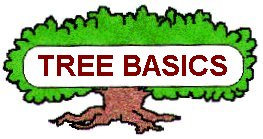 |
Click on images to see a larger
version. Then click on your "BACK" button to return to the glossary.
There are many thumbnails and quite a few terms on this page. Please allow
time for the page to load into your browser.
| ACRE: An area of land consisting of 43,560 square feet, roughly the size of a football field. In land survey, an acre is a square 208.7 feet on a side. | |
| AFFORESTATION: New forest on open land that was either never forested or had not been forested for many years. See reforestation and deforestation. | |
|
ALIEN: Refers to the geographical origin of a species beyond the region considered. For example, a species whose origin is from Europe or Asia would be considered an "alien" or "exotic" in North America. Similarly, a species from a different region of the country would be "alien" here in the Lake States, such as Colorado blue spruce.. |
 |
| ALL-AGED FOREST: A forest or stand of timber where individual trees represent the natural range of ages for the species making up the stand. This a natural condition for trees that are tolerant of shade (e.g. sugar maple, basswood, hemlock, el al.). "Uneven-aged" forest can be used as a synonym. | |
| ALTERNATE BRANCHING: A branching pattern where side branches, leaves, and leaf scars do not grow directly across from each other. The more common branching pattern. |
 |
| BARE-ROOT SEEDLING: Seedlings grown 2-4 years in a nursery, then up-rooted and planted. Tree nursery practices include root pruning, fertilization, transplanting, and chemical control. Bare-root seedlings have coded numbers that indicate the number of years since germination and the number of years since transplant. "3-0 red pine" would be stock that spent three years in the nursery but was not transplanted. "3-1" red pine spent three years in the nursery, then was transplanted and grown for another year. Total age would be 4 years. Older trees have better chances of survival but are larger and more difficult to plant. See "containerized" seedlings. | |
| BARK LAYERS: In elms, the bark forms distinct layers as the tree trunk grows outward. If you break off a thick piece of bark and look at the cross-section, you will clearly see layers. With American elm, the layers are white/cream and red/brown. | 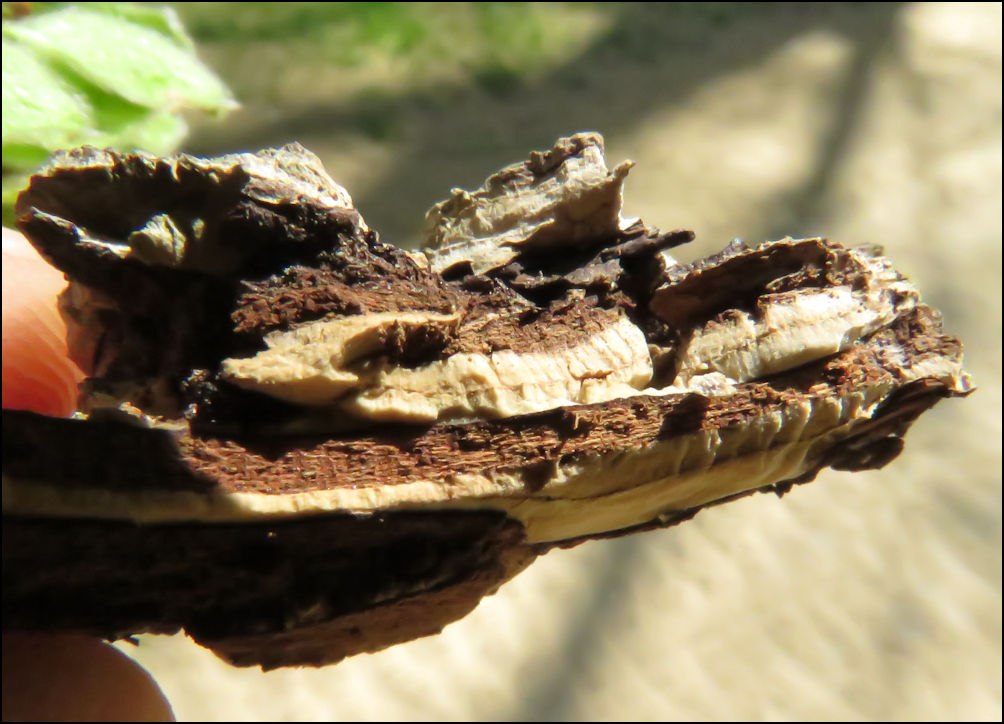 |
| BASAL AREA: A measure of stand density in units of square feet per acre. The number of square feet that cross-sections of tree stems occupy . . . the sum of circular areas at a point 4.5 feet from the ground. Typical basal area for Michigan forests runs between 70 and 150 square feet per acre (43,560 square feet in an acre). Stand density is a measure of available light, which is critical to plant growth, too dense means slow growth, not dense enough means unoccupied space. | |
| BOLT: A log, usually 8 feet long, with variable specifications depending upon buyer needs and the market. Usually of lesser quality than a sawlog, but not necessarily. | |
| BLUNT: The opposite of sharp. Usually refers to the shape of terminal bud. | |
| BMPs: Best Management Practices. These are voluntary guidelines for the protection of water bodies, soils, and riparian areas, primarily applied to logging operations and road construction/maintenance. | |
| BOARD FOOT: A volume of wood equivalent to a board one-inch thick and twelve inches on a side, accounting for the width of saw kerf during manufacturing. Therefore, a block of wood 12 inches on a side would contain less than 12 board feet. In log and tree volume tables, board foot measure takes into account taper and excludes volume in slabs. There are three main "scales" that estimate board foot volume in logs, Scribner, International, and Doyle. Timber volume is usually expressed as MBF, or the number of thousand board feet. | |
| BROAD-LEAFED: Trees and shrubs with flat leaves are called "broad-leafed". This is different from the conifers, which have needles or scales. So, a "broad-leaved" tree is a non-conifer, which includes most of our species. "Broad-leafed" trees are also called "deciduous" trees or "hardwoods". | |
| BUCK: The sawing of tree stems into lengths. With quality sawtimber, proper bucking is critical to maximize dollar value. In pulpwood and lower quality wood, bucked lengths are usually 8 feet (plus trim). | |
| BUFFER STRIP: A width of forest retained during a harvest operation that lies along a water body or as a visual barrier, such as along a road or trail, or adjacent to a campground. Buffer strip width varies with each situation. Timber harvest operations are limited or prohibited in buffer strips. | |
| BUTT LOG: The log cut nearest to the stump. Generally the highest value log in a tree. | |
| BUDS: Both leaves and flowers begin as buds. Leaves form as either "terminal" buds at the ends of twigs or "lateral" buds along the sides of twigs. Most buds have protective scales that enclose the leaf tissue. Buds without scales are called "naked". Flower buds form in various places and are often much larger than leaf buds. All buds are usually set by the end of the summer, in preparation for the next growing season. |  |
| BUNDLES: Members of pine family (not other evergreens!) have groups of needles held together at the base by a small papery wrap called a "fascicle." In Michigan, white pine has five needles per bundle, and other pine species have two. Tamarack and larch appear to have many needles in bundles, but they are really clusters of needles at the end of short stubby twig. |
 |
| CAMBIUM: These thin tissues are found between the bark and woody tissues of a tree. Bark cambium produces new bark and wood cambium produces more wood. Other growth tissues in a tree are meristems, located in the tips of twigs and roots. | |
| CANOPY: The collective tree crowns in a forest situation forming a layer over the forest floor. A canopy may consist of several layers, depending upon the structure of a particular forest stand. | 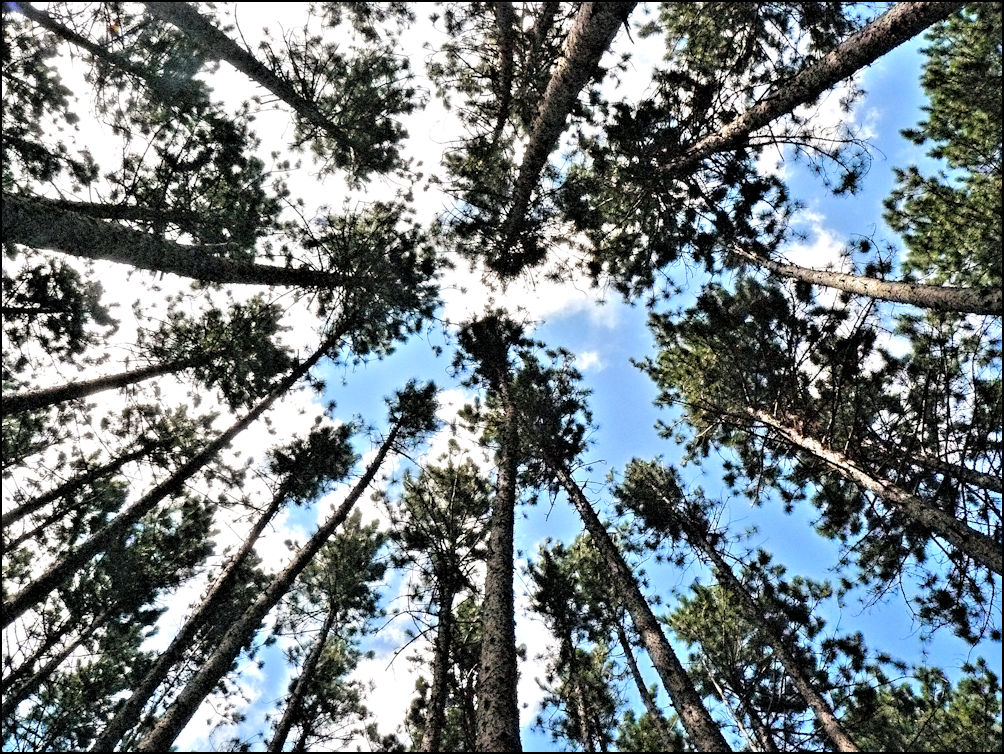 |
| CARRYING CAPACITY: The number of animals an area can support on a long-term basis without damage to the landscape or mortality factors outweighing natality. Carrying capacity will vary with seasonal fluctuation and is usually lowest in winter. | |
| CATKINS: A cluster of flowers that forms a long, skinny, caterpillar-like shape is called a "catkin". Catkins are typical of aspens, willows, oaks, birches, butternuts, and walnuts. | 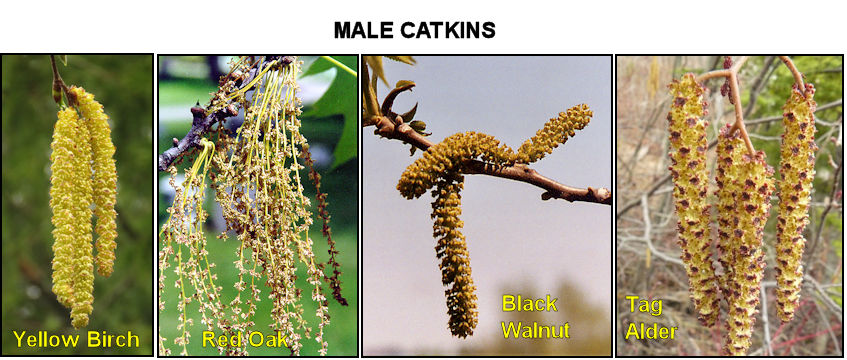 |
| CHAMBERED PITH: The "pith" is the inside core of a twig, the first-formed wood. In butternuts and walnuts, the pith is formed by a series of tiny chambers which can be seen if the twig is sliced open. | 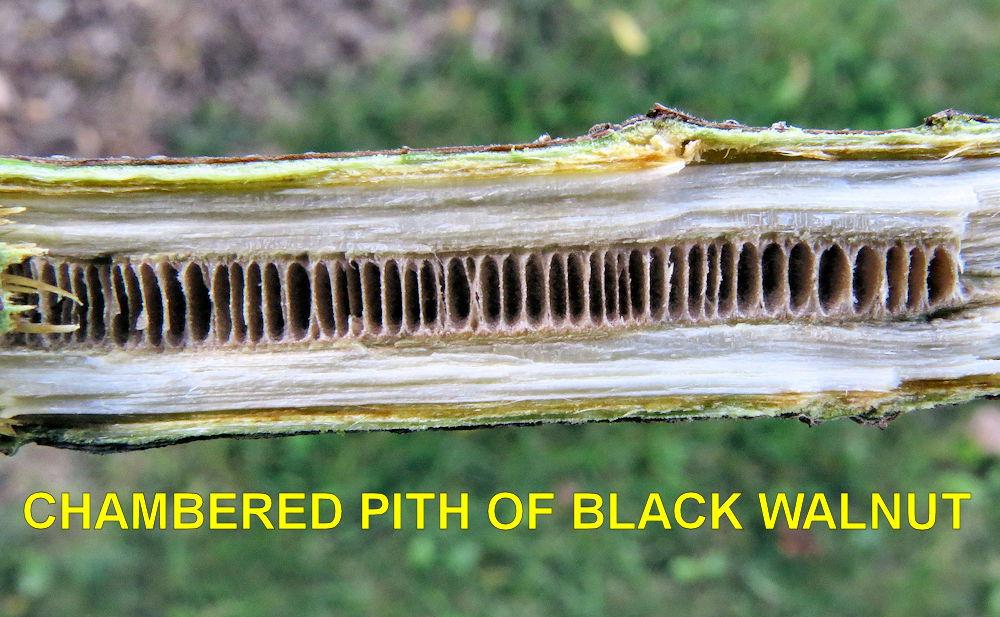 |
| CHAIN: A linear measure of 66 feet used in land survey. A mile equals 80 chains. An acre has 10 square chains. | |
| CLEARCUT: A timber harvesting system where all or most of the trees in an area are removed. An even-aged regeneration method for shade-intolerant tree species. Note that in forestry vernacular, the word "clearcut" is not hyphenated. | |
| CLONES: Individuals that are genetically identical are called clones. This is the result of reproduction without flowers and seeds. Aspen is a great example of a tree species that occurs in clones. | |
| CO-DOMINANT: Refers to an individual tree position in a forest canopy. A tree crown in the main canopy with roughly equal ecological effect in the forest. See also: super-canopy, dominant, intermediate, and suppressed. | |
| COMMERCIAL FOREST LAND: Forest open to timber harvesting that is capable of growing at least 20 cubic feet (1/4 cord) of wood per year per acre. It is not necessarily land owned by forest industries. Same as "timberland". Forest enrolled in Michigan's Commercial Forest Program is a subset of the statewide "commercial forest" and accounts for about two million acres of forest. | |
| COMPOUND LEAVES: A single leaf with numerous leaflets. A leaf begins where the leaf stem connects to the wood tissue of the twig. Sometimes, the leaf stem supports these leaflets that look like individuals leaves but the leaf stem is not woody. Ashes, boxelder, and butternuts display this characteristic. Double-compound is when each leaflet is also made up of secondary leaflets. Honeylocust is the only U.P. tree that is double-compound. The Kentucky coffee-tree is also double-compound and grows in the very southern part of Michigan. |  |
| CONIFER: A "conifer" can also be called an "evergreen" or "softwood" tree. Conifers have needles. However, it is inaccurate to call all conifers "pines"! There are only three native pine tree species in Michigan. (white, red & jack) and nine species of native non-pine conifers (balsam fir, white-cedar, redcedar, junipers, hemlock, black & white spruce, tamarack, and yew). True pines (genus Pinus) make up only 15% of the total volume in Michigan, and about half the total conifer volume. . | |
| CONTAINERIZED SEEDLING: Seedlings grown in containers with many small "cells" each holding a seedling. Typically, the containers are stryofoam blocks with over 100 cells. Seedlings are planted with soil "plugs" the seed germinated in. See "bare-root" seedlings. | |
| CORD: A pile of eight-foot logs (or 100" pulpsticks) that is four feet tall and four feet wide. That is a space of 128 cubic feet, but an average cord has about 79 feet of solid wood. The rest of the space is air. | |
| CORDUROY ROAD: Where roads crossed wetland, small diameter logs were placed across the road to support hay wagons and other traffic. Cedar was often the log of choice due to its rot-resistant character. Some of these old corduroy roads can still be found, decades after they were constructed. May also be slash laid down along a skidding route to minimize soil compaction by logging equipment. | |
| CROWN: All the branches of a single tree that hold the leaves are collectively called a "crown". It's the "lollipop" portion of the tree. Sometimes crown size and shape help identify a tree, as with balsam fir or basswood. All the crowns of a forest are called a "canopy" . | |
| DBH: Diameter Breast Height. A standard place to measure a tree diameter, 4.5 feet from the ground. This point is easy to reach and avoids the trunk flare at the base of the tree. | |
| DECIDUOUS: Trees and shrubs that lose their leaves or needles in the fall are called "deciduous". Leaves and needles that remain on the tree through the winter, are part of the way into winter, are called "persistent". Except for tamarack, deciduous trees can also be called "broad-leafed" trees or "hardwoods". | |
| DEFOLIATION: The partial or complete loss of leaves, usually due to insects or diseases. Most trees can recover from a year of complete defoliation with only a partial loss of annual growth. | |
| DEFORESTATION: A more-or-less permanent land use change from a forested condition to something else, most often agricultural lands, urban sprawl, or rural splatter. Forest management using clearcutting is NOT deforestation as the land soon supports a new forest. See afforestation and reforestation. | |
| DISK TRENCHING: Furrows dug into the soil by a plow pulled behind a large machine in preparation for tree planting. | |
| DOMINANT: Refers to an individual tree position in a forest canopy. A tree crown above the main canopy receiving light on at least three sides. Has above-average ecological effect in the forest. See also: super-canopy, co-dominant, intermediate, and suppressed. | |
| DRUMLIN: A landscape feature. An elongated, teardrop-shaped hill created from the debris of a retreating glacier. The "head" of the drumlin points in the direction of glacial retreat. The "tail" becomes gradually lower and narrower. | |
| ECOSYSTEM: The inter-related living organisms (including humans!) and non-living components of an area. The area can be defined many ways, resulting in any size ecosystem, from a fallen tree to the entire Earth. | |
| EDGE EFFECT: The impacts related to the zone where two or more ecological communities meet. Typically, species diversity is higher along the edges than the interiors of each of the constituent communities. | |
| EPICORMIC BRANCHING: Branches originating from buds within the bark. Epicormics often fail to contribute to overall tree health and cause defects in quality sawtimber and veneer. Avoiding epicormic branching can be done through maintaining sufficient amounts of shade in a forest. This is particularly important with selection management of sugar maple. | |
| ESKER: A landscape feature. A linear, serpentine ridge from glacial debris from a stream bed inside a glacier. | |
| EVEN-AGED: A stand condition where most of the trees are within 20 percent of the rotation. | |
| EVERGREEN: An "evergreen" can also be called a "conifer" or "softwood" tree. However, it is inaccurate to call all conifers "pines"! There are only three native pine tree species in the U.P. (white, red & jack) and nine species of non-pine conifers (balsam fir, white-cedar, redcedar, junipers, hemlock, black & white spruce, tamarack, and yew). True pines (genus Pinus) make up only 15% of the volumer of conifers in Michigan. | |
| EXOTIC: Refers to a species outside the native geographical area of origin. For example, a species whose origin is from Europe or Asia would be considered an "alien" or "exotic" in North America. Or, Colorado blue spruce is an exotic species in the Lake States. | |
| FAUNA & FLORA: Animals and plants. | |
| FISSURED: A bark characteristic describing grooves and ridges. Usually the grooves (or fissures) or fairly deep. Sometimes looks like cracks or splits. | |
| FLOODPLAIN: The flat land along a stream or river that floods on a regular basis, sometimes every year. The soils are often quite rich with new nutrients brought in by floodwater. Trees that grow in floodplains must be adapted to saturated soils that occur on the site. Floodplains are part of the "riparian" habitat, which is the general zone along lakes and rivers. | |
| FLORA & FAUNA: Plants and animals. | |
| FLOWERS: All trees have flowers but not all are showy. Some flowers have both male and female parts. Other flowers may be only male or only female. Sometimes, male and female flowers occur on separate trees. The female parts consist of ovaries, stigmas, and styles. The male flowers consist of stamens and anthers. Petals or petal-like parts, when they are present, are usually associated with flowers that have female parts. Ovaries occur at the base of a flower and have a tube, called a style, with a sticky end, called a stigma. It is sticky to help catch pollen grains. Fertilized ovaries will grow into fruits. The anthers produce pollen, usually at the end of thin stalk called the stamen. | |
| FOLIAGE: A word that means "leaves in general", such a a group of leaves or all the leaves on a branch. Usually it's better to simply say leaves or needles, but in the case of cedar the "foliage" does not fit into one of those categories as people normally think about them. Technically, however, leaves include needles and all other seasonal plant structures with the primary job of photosynthesis. However, we usually associate "leaves" with just hardwoods. | |
| FORD: A stream-crossing without a bridge or structure. | |
| FOREST: A vegetation community dominated by trees. | |
| FOREST MANAGEMENT SYSTEM: A complete set of forest cultural practices designed to harvest, regenerate, and improve a stand of timber. Management systems are custom-designed to match ecological, economic, and socio-cultural demands. Shade tolerance and succession are critical ecological variables. | |
| FOREST TYPE: An association of particular group of tree species, named for the dominant tree species. From the Society of American Forester it is "a category of forest usually defined by its vegetation, particularly its dominant vegetation as based on a percentage cover of trees, ... " An ecological association of plant species dominated by a particular groups of tree species. For example, northern hardwoods refers to stands of mostly sugar maple, basswood, beech, and yellow birch. The aspen forest type will be mostly quaking aspen or bigtooth aspen. U.S. Forest Service inventory data recognizes about 15 forest types in Michigan. |
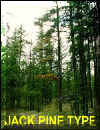 |
| FORESTER: A person with a degree from a university forestry program that has been accredited by the Society of American Foresters, and works in one of the many aspects of forestry. There are a number of other professional creditionals, such as Certified Forester, membership in the Association of Consulting Foresters, state programs, and other credentials. Loggers are typically not foresters, although logging is an essential aspect of professional forestry. | |
| FORESTRY: The profession using the art and science of growing sustainable forests for the benefit of people. | |
| FORWARDER: A machine used to move logs from the forest to a landing. A forwarder picks-up logs for placement in a bunk, then carries them out of the woods, rather than dragging the logs. See "skidder". | |
| FRAGMENTATION: The process where pieces of a larger tract of forest are deforested, often for agriculture, homes, golf courses, roads, and other uses. Ownership "fragmentation" is better termed "parcelization". | |
| GENUS: "Genus" is the next to the lowest level of plant or animal classification. The lowest level is "species". All known living organisms are organized into a classification system. This is part of the science called "taxonomy". Scientists refer to living things by a combined "genus" and "species" name, using Latin terms. For example, people are called "Homo sapiens". A white pine would be called "Pinus strobus". A scientist anywhere in the world can look up information about any living organism by knowing the Latin or scientific name. The genus name is always capitalized. The species name is not capitalized, even if it's something like "americanum" or "canadensis".. The plural form of "genus" is "genera". The singular form (and pural) of "species" is "species". | |
| HABITAT: The environment in which an individual or species (plant or animal) occupies. Basic habitat requirements include water, food/nutrients, and protection. Requirements for any particular species can change seasonally, geographically, and with age. | |
| HARDWOOD: Trees and shrubs with broad-leaves (not needles or scales) that drop in the fall are called "hardwoods". Hardwood trees can also be called "broad-leafed" trees or "deciduous" trees. | |
| HERBICIDE: A manufactured chemical that kills plants. See "pesticide". | |
| HIGH-GRADING: A destructive harvest practice where only the larger and more valuable trees are removed, leaving a degraded stand behind. "Diameter-limit" cut is a near synonym. Sometimes incorrectly referred to as "select cutting". | |
| IMPROVEMENT CUT: A cut designed to better the timber quality or other stand conditions. Improvement cuts can be commercial or non-commercial depending the the stand. | |
| INTERMEDIATE: Refers to an individual tree position in a forest canopy. A tree crown within the lower part of the main canopy ready to quickly occupy the position of a dominant or co-dominant tree that might die. Has below average ecological effect in the forest but is reasonably healthy. See also: super-canopy, dominant, co-dominant, and suppressed. | |
| INTERSPECIFIC COMPETITION: Usually associated with wildlife population dynamics. The competition among scarce resources between different species. See "intraspecific" competition. | |
| INTRASPECIFIC COMPETITION: Usually associated with wildlife population dynamics. The competition among scarce resources among individuals of the same species. See "interspecific" competition. | |
| KAME: A landscape feature. A conical hill of glacial debris, often formed from material in a waterfall erupting from a retreating glacier during a stationary period. | |
| KERF: The volume of wood that a saw removes during the manufacture of lumber. Band saws typically have a narrower kerf than circular saws. | |
| LANDING: The place in a fores or along a road where logs are brought to for loading onto trucks. | |
| LATERAL: A word referring to the "side of" something. Lateral branches are those growing out of the sides of other branches. Lateral veins would be those coming from the mid-vein of a leaf. | |
| LAYERING: A reproductive method used by few tree species where roots sprout from live branches or trunks that have come into permanent contact with the soil. | |
| LEAF BASE: The bottom of the leaf at the stem. The angle at which the leaf base joins the stem is helpful in tree identification. Sometimes the base is "flat", other times it may be angled away from the twig (most leaves), or back to the twig (e.g.. cottonwood & basswood). An "unequal leaf base" is when the two sides of the leaf base may not join with the leaf stem in the same place, as with American elm. | |
| LEAF SCAR: The mark left on a twig after the leaf drops in the Fall. Each leave scar has a particular pattern of "bundle scars", which is where the leaf vessels passed into the twig. |
 |
| LEAFLETS: Compound leaves are composed of several "leaflets". These leaflets look like individual leaves but are not. The leaf starts where the woody twig tissue ends. This is not always easy to see. Ashes and boxelder are common U.P. trees that have compound leaves with leaflets. |
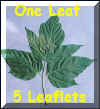 |
| LENTICLES: Small bumps or spots on twigs that serve and "breathing" holes for the twigs. Often used as an identifying characteristic in tag alder and birches. |
|
| LOBES: Lobes are "fingers" or "peninsulas" that make an irregular leaf shape. Maples and oaks are best known for their lobed characteristic. The indentations between lobes are called "sinuses". Margins can smooth or toothed. |
 |
| LUMP-SUM TIMBER SALE: Stumpage for an entire tract of timber based on volume estimates. See "scale-sale". | |
| MANAGEMENT PLAN: A written document particular to a specific tract of forest. Plans include such information as forest owner objectives, property description, natural resource inventories, a schedule of intended projects/harvests, etc. | |
| MARGINS: The leaf "margin" refers to the edge of the leaf. The edge may be toothed or smooth, lobed or entire, or of other sorts of descriptions. "Serrated" refers to a pattern resembling that of a hand saw. |
 |
| MARSH: A type of wetland without trees. A wetland with trees is a swamp. | |
| MAST: Trees and shrubs that produce nuts (hard mast) or berries (soft mast). | |
| MATURE FOREST: A stand condition where a high percentage of trees have reached or recently past the peak growth of their lifespan. Economic maturity is where a tree has reached the peak monetary value. Biological and monetary maturity may not necessarily occur at the same time, economic maturity usually comes first. | |
| MERCHANTABLE HEIGHT: A portion of a tree stem that meets certain raw wood product specifications. Sawtimber merchantable height extends from the stump up to a specified stem diameter, often 7 or 9 inches. Pulpwood merchantable height typically is the point where the stem diameter is 4 or 5 inches. A large tree might have both a sawtimber and a pulpwood merchantable height. Other factors such as disease or stem form might reduce merchantable height. | |
| MERISTEM: These are specialized cells in the tips of twigs and roots that form new support tissue, buds, flowers, and related structures. Other growth tissues in a tree are called cambium, located between the bark and wood of trunks, branches, and roots. | |
| MICROTOPOGRAPHY: The small scale bumps and holes on a forest floor. In a wetland soil, trees will grow on the bumps but not in the holes. Tree roots typically do not grow in saturated conditions. When trees blowdown and are uprooted, they form "pit and mound" topography. The root ball and tree trunk form "mounds". The hole from where the roots came is the "pit". On richer upland sites with thick layers of organic matter, the exposed mineral soil from blowdowns are one of the few places for some tree seeds to successfully germinate. | |
| MONOTYPIC: A taxonomic classification containing a single genus and single species. | |
| MORAINE: A landscape feature. A network of glacial debris hills created at the leading edge of a glacial (terminal moraines) or in between lobes of glacier (lateral moraines). | |
| MORPHOLOGY: The study of structures in living things. | |
| MORTALITY: Death. The relative importance of factors causing death (predators, disease, weather, etc.) vary over time and with population size. A critical measure in population dynamics of plants or animals. Near carrying capacity, mortality reaches peak levels. | |
| MYCORRHIZAE: Pronounced "my-core-hi-zee", this a group of beneficial fungi associated with most tree roots. It represents an ecologically symbiotic relationship where the fungi receive food from the tree and the trees receive greatly enhanced nutrient and water absorption. Mycorrhizae will also protect tree roots from other invading fungi. There tends to be very specific species relationships between fungus and tree. | |
| NATALITY: The capacity of a species population to reproduce and grow in numbers. The relative importance of factors leading to population growth vary over time and with population size. Near carrying capacity, natality reaches low levels. | |
| NATIVE: A species which developed and evolved in a particular area and was present prior to European settlement. | |
| NATURALIZED: Species which are not native, have been introduced, and now widely reproduces in our area. | |
| OLD GROWTH FOREST: There are many definitions of old growth, but most include some mention of significant numbers of trees nearer the end of their biological longevity, structural components of a stand, presence of large fallen logs, later stages of succession, and other factors. Old growth is not merely the presence of large diameter trees, nor does it necessarily have high species diversity. | |
| OPPOSITE BRANCHING: A branching pattern where side branches, leaves, and leaf scars grow from the stem directly across from each other. For U.P. trees, that identifies either a maple or ash. Many shrubs, however, also have opposite branching, such as dogwoods and viburnums. |
 |
| OVERMATURE FOREST: A stand condition where a high percentage of trees are near the end of their biological longevity, net growth is near or below zero, and the incidence of decay organisms is high. See "mature" forest. | |
| OVERSTOCKED: A stand condition where tree density is beyond the point where individuals trees can grow in a healthy and vigorous manner. Stand density is measured in "basal area". Optimum stand density will vary with forest type and stand age. | |
| OVERSTORY: The larger trees that stand above small trees and ground vegetation. | |
| PALMATE: A particular shape of leaf where the main leaf veins begin at the same place near the leaf stem. Named after the shape of a hand with the fingers spread wide. Maple is the classic example of "palmate-shaped" leaves. |
 |
| PARCELIZATION: The process of land ownership being broken into increasingly smaller tracts. The term "fragmentation" is frequently incorrectly used to describe this process. Parcelization in Michigan is a serious to the forest industry and long-term ecological sustainability. | |
| PESTICIDE: A chemical or other agent designed to kill certain living things. An herbicide kills plants. An insecticide kills insects. A fungicide kills fungi. Many pesticides are specific in what they kill. For example, Bt (Bacillus thuringiensis) is an insecticide that kills caterpillars. | |
| PITH: The center or inside of a twig, branch, or stem is called the "pith". The kind of wood in the pith is often different than the kind of wood around the outside. In some species, the pith has some really weird properties. It might be a different color, or be really soft, or even have chambers. | |
| PHOTOSYNTHESIS: The chemical process that
green plants use to produce sugars (and oxygen) from carbon dioxide and water, thereby
capturing solar energy for use in other chemical processes and tissue building activities
of the plant. CO2 + H20 -----------------> SUGAR (C6H1206) + O2 |
|
| PHYSIOLOGY: The study of functions and processes in living things. | |
| POLE: A tree size class. Trees over 5 inches in diameter and under 9-12 inches (species dependent) in diameter. See size classes. See size class. | |
| PULPWOOD: Cut wood destined to be manufactured into wood pulp, then paper. Generally smaller diameter logs/sticks or low quality sawtimber-sized logs. Pulpwood can also refer to stands made up of mostly poletimber. | |
| RACEME: A particular arrangement of flowers that is long and narrow. Short flower stems branch off of a single (usually) main stem. A common flower arrangement in some of the cherries. | |
| REFORESTATION: New forest on open land that had been recently forested. See afforestation and deforestation. | |
| RESIDUAL: Usually applied to either a tree or a stand, it is the trees left after a timber harvest or natural disturbance such as wind or fire. | |
| RIPARIAN ZONE: This is a band of undefined width that lies adjacent to stream courses and lake shores. Topography, soils, and vegetation affect the width of such zones. | |
| ROTATION: The number of years between regeneration and final harvest in the management of even-aged forest stands. | |
| SALVAGE CUT: Timber harvested from an area following a catastrophic disturbance such as wind, wildfire, or insect/disease epidemic. Downed timber must be harvested within a year or two before the effects of decomposer organisms render the wood unmerchantable. | |
| SAMARA: A kind of fruit. Thin "wings" are attached to the seed. Maples have "helicopters", the most commonly known samara. However, ashes and elms also have samaras. |
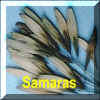 |
| SAPLING: A tree size class. A small (usually young) tree between 1-5 inches in diameter. See size class. | |
| SAWTIMBER: A tree size class based on diameter. In Michigan, hardwood sawtimber typically has 11+ diameters and softwood sawtimber typically has 9+ diameters. See size class. | |
| SCALE SALE: A timber sale where stumpage prices for each raw wood product are agreed upon and payment is made according to what is harvested from a stand. See "lump-sum" sale. | |
| SCALING: Measuring the volume of logs, usually in units of board feet or cords. | |
| SCALY: Evergreen "needles" that are flattened and overlapping are called "scaly." They look sort of like scales on a fish. Northern white cedar is the only evergreen with scaly "needles." | |
| SCARIFICATION: Breaking up the organic surface layer of the ground to expose mineral soil. This is done to allow the seeds of certain tree species to successfully germinate in order to achieve good forest regeneration. Pronounced SCARE-ification, not SCAR-ification. | |
| SELECTION: A timber harvesting system of partial harvests at 10-15 year intervals where quality tree growth is the objective. Removed trees are of inferior quality or species, leaving an improved stand condition. Individual or groups of trees are marked with paint for harvest. The selection system is NOT "selecting" just the large or most valuable trees for harvest. See high-grading. An uneven-aged or all-aged regeneration method for shade-tolerant tree species. | |
| SEEDLING: A tree size class. A small (usually young) tree typically over 12 inches and height and less than 1 inch in diameter. See size class. | |
| SEEDTREE: A timber harvesting system where most of the trees in an area are removed. The remaining trees serve as a seed source for regeneration and must be windfirm species and able to disperse seeds widely. An even-aged regeneration method for shade-intolerant tree species. | |
| SFI: Sustainable Forestry Initiative. The SFISM is a program of the American Forest & Paper Association. It's a comprehensive system of principles, objectives and performance measures, that integrates the long-term, sustained growing and harvesting of trees, with the protection of the environment in which they grow. | |
| SHELTERWOOD: A timber harvesting system where all or most of the trees in an area are removed in two or three cuts, over a 5-10 year period. The first cut is designed to establish regeneration, if it's not already present. The second cut manipulates light conditions to optimize seedling growth and add maximum volume growth on residual trees. The third cut removes the overstory. An even-aged regeneration method for shade-intolerant tree species. | |
| SHRUB: "A woody, perennial plant differing from a perennial herb in its persistent and woody stem, and less definitely from a tree in its lower stature [size] and the general absence of a well-defined stem" [Society of American Foresters, 1998]. The problem is that some species can grow as trees or shrubs depending on climate and site conditions. Species we might usually consider a shrub can sometimes grow to tree size. A good example is juneberry. Usually a shrub, it can grow to heights of 50 feet and over a foot in diameter under the right conditions. | |
| SILHOUETTE: The outline of a tree as seen from a distance. The overall form and shape of a tree. Many tree species have easy to recognize silhouettes, such as American elm, balsam fir, white pine, and sugar maple. | |
| SILVICULTURE: The art and science of controlling the establishment, growth, composition, health, and quality of forests to meet the diverse needs and values of landowners and society on a sustainable basis (Society of American Foresters, 1998). | |
| SIMPLE LEAVES: A single leave stem is the same as the midrib. Most of our U.P. tree species have simple leaves. The leaf margins, however, have a wide variety of shapes that help identify trees. | |
| SINUSES: Leaf sinuses are the area between lobes. Maples and oaks are typical examples of trees with "lobes" and "sinuses". |
 |
| SITE INDEX: A numeric predictor of how productive a site is in producing timber. A technique using the height and age of trees is probably the most common. However, over the last 20-25 years, a technique using the presence and relative abundance of understory flora has become increasingly refined. | |
| SITE PREPARATION: A collection of practices and techniques used to change the ground surface conditions in order to favor the germination and survival of tree species. Sites are almost always treated prior to planting to increase seedling survival. | |
| SIZE CLASS: Categorization of trees based on diameter at breast height (dbh). Seedlings are under 1 inch. Saplings are 1-5 inches. Poletimber is 5 inches to 9-12 inches (species dependent). Sawtimber is over 9-12 inches (species dependent). Size classes can be broken down into more specific dbh categories, such as every 2 inches. | |
| SKIDDER/SKIDDING: Moving logs or cut tree stems to a landing for either loading onto a truck or further processing. A skidder is a machine that is used to drag the logs. See "forwarder". | |
| SLASH: Tree debris left in the forest following a harvest operation, consisting mostly of leaves and branches. | |
| SNAG: A dead standing tree. Large snags with hollow parts are particularly beneficial for many species of wildlife. | |
| SOFTWOOD: A "softwood" can also be called an "evergreen" or "conifer" tree. However, it is inaccurate to call all conifers "pines"! There are only three native pine tree species in the U.P. (white, red & jack) and seven species of non-pine conifers (balsam fir, hemlock, cedar, black & spruce, tamarack, and yew). True pines (genus Pinus) make up only 15% of the number of conifers in the U.P. | |
| SPECIES: A "species" is generally accepted as a group of individuals that look the same and can breed with each other but not usually with individuals of another species. "Species" is the the lowest level of plant classification. This is part of the science called "taxonomy". Scientists refer to living things by a combined "genus" and "species" name, using Latin terms. For example, people are called "Homo sapiens". A white pine would be called "Pinus strobus". A scientist anywhere in the world can look up information about any living organism by knowing the Latin or scientific name. The genus name is always capitalized. The species name is usually not capitalized. Incidentally, the word "specie" is incorrect. "Species" is the correct singular and plural form of the word. | |
| SPROUTS: One of methods some trees use to reproduce is to sprout from dormant buds. Usually these buds are located around the root collar, near the ground. If the parent tree should weaken or die, these dormant buds will often grow into sprouts. This is common with species such as oak and birch. Sprouts which grow from dormant buds on the root system are called suckers. This is typical of aspens. | |
| STAND: An area of forest where the combination of trees share common biological and ecological factors. Adjacent stands have enough differences to be distinguishable from each other. | |
| STAND DENSITY: A combinations of tree diameter and number of trees per acre. Stand density is critical measure of forest conditions. It is measured in "basal area" with units of square feet per acre. | |
| STIPULES: Bumps or growths at the bottom of a leaf stalk. Sometimes leafy-looking. Common in members of the rose family. Also helps separate black willow from peachleaf willow. | |
| STOCKING: The number of trees per acre. Charts have been developed that show the optimum number of trees per acre based on the average diameter. | |
| STOMATE: Small openings in leaves that permit the passage of air for respiration and photosynthesis. Leaves have the ability to open and close stomates. | |
| STOUT: Twigs come in various thicknesses. "Stout" twigs that tend to be rather thick or chunky. |  |
| STUMPAGE: The price a logger pays a landowner for trees on the stump. A landowner might be a private citizen, a business, or a government agency. These are the monies a landowner receives for selling their timber. Stumpage values can vary widely, even for the same species and product. Many variable factors must be considered when establishing stumpage prices. | |
| SUCCESSION: The orderly and predictable series of vegetation type changes over time. Primary succession begins with bare soil, or nearly so. Secondary succession begins at some point earlier in the process than what was present before. Succession is a critical concept in developing forest management systems. | |
| SUCKERS: One of methods some trees use to reproduce is to sprout from old root systems. If the parent tree should weaken or die, these dormant buds will often grow into suckers. This is typical of aspens. If suckers grow from stumps or around the bottom of the trunk, they are called stump sprouts. This is common with species such as oak and birch. | |
| SUPER-CANOPY: Refers to an individual tree position in a forest canopy. A tree crown almost entirely above the main canopy, receiving light from all sides. Also called an emergent tree. See also: dominant, co-dominant, intermediate, and suppressed. | |
| SUPPRESSED: Refers to an individual tree position in a forest canopy. A tree crown below the main canopy. Has below average ecological effect in the forest and is growing very slowly and is likely physiologically stressed. See also: super-canopy, dominant, co-dominant, and intermediate. | |
| SUSTAINABLE FORESTRY: Forest management designed to meet the demands of society for future generations. | |
| SWAMP: A wetland with trees. | |
| SWEEP: Refers to gradual bends in the trunk of a tree leaving the trunk less than straight. |  |
| TANNIN: A brown-colored chemical found in plants. Tannin can be used to soften animal hides for use as leather. Hemlock and oak bark was an important source of tannin during the settlement of the Lake States. | |
| TEMPERATE CLIMATE or ZONE: There are a number of global climate descriptions, one of which is "temperate". This climate is the one in U.P. and extends across much of the USA. Temperate forests are dominated by hardwood species, have warm summers, cold winters, and rainfalls in the 20-60 inch range. On the north is the boreal zone, to the south is the subtropical zone. | |
| TIGHT: A bark characteristic meaning firm, not peeling, not loose, not peeling. "Tight" bark on older trees may become furrowed or split, but does not rub off or peel off easily. | |
| TIMBER: Usually refers to stands of trees with volumes in merchantable size classes. It can also refer to forests or woodlands, in general. | |
| TIMBERLAND: Forest open to timber harvesting that is capable of growing at least 20 cubic feet (1/4 cord) of wood per year per acre. Same as "commercial forest". Using federal definitions, timberland is different than forest. Timberland has definitions for minimum volume, number of trees, area dimensions, and growth rates. It is a subset of forest land. These definitions eliminate small parcels, other land uses that have just a few trees, inaccessible forest, and very poor growing forest. | |
| TOLERANCE: The ability of tree species to withstand a particular environmental factor. Typically, "tolerance" is mean shade tolerance, or a tree's ability to germinate and grow at various levels of shade. Aspen and jack pine are good examples of trees very intolerant of shade. Sugar maple and northern white cedar are relatively shade tolerant. This is a critical ecological characteristic used in the development of forest management systems. | |
| TOOTHED MARGINS: Some trees have leaf margins with variously sized and shaped "teeth" that help identify the species. "Single-toothed" means all teeth are about the same size and shape. "Double-toothed" means a fewer number of larger teeth and many smaller teeth on them and sometimes in-between the larger teeth. "Serrated" refers to a pattern resembling that of a hand saw. |  |
| TREE: It might seem silly, at first, to define a tree. Everyone knows what a tree is . . . don't they? The difference between and tree and shrub can be defined without difficulty. A tree is "a woody perennial plant, typically large and with a well-defined stem or stems carrying a more or less definite crown --- note sometimes defined as attaining a minimum diameter of 5 inches and a minimum height of 15 feet at maturity, with no branches within 3 feet of the ground" [Society of American Foresters, 1998]. The problem is that some species can grow as trees or shrubs depending on climate and site conditions. A good example is black cherry. Throughout most of its range, it grows as a tree. But put on a poor site or along the northern edge of its range and it grows as a shrub. Species that are obviously trees further south will sometimes occur only as shrubs in the far north. | |
| UNDERSTORY: Forest vegetation is usually arranged in "layers", from the ground to the top of the forest canopy. The biggest trees are called dominants or codominants. The next layers are shorter trees either pushing their way into the canopy or suppressed (sickly) by the shade. Sapling trees and shrubs for the "understory". Below the understory are the small plants, herbs, grasses, ferns, etc. | |
| UNEVEN-AGED: A stand condition where three or more distinct ages classes are individually mixed or occur in small pockets throughout the stand. In Michigan, northern hardwood types are commonly managed with an uneven-aged objective. When all ages classes become present, the term "all-aged" is sometimes used. | |
| VENEER: A thin layer of wood used in the manufacturing of panelboard. High quality veneer is glued to the outside surface. Lower quality wood (solid, manufactured, or veneers) makes up the interior and back sides of a panel. Veneer quality sawlogs mean logs that have exceptionally few defects. | |
| WATERSHED: The area drained by a particular stream, river, or lake. Small streams have smaller watersheds. Large river systems have large watersheds, with many component watersheds of its tributaries. The Great Lakes watershed covers a large portion of North America. | |
| WINDTHROW: Trees that have been broken, uprooted, leaned-over by strong winds. | |
 |
This website was developed and created by Michigan State University Extension for the teachers of the State of Michigan. |
Page Name:
Glossary.htm